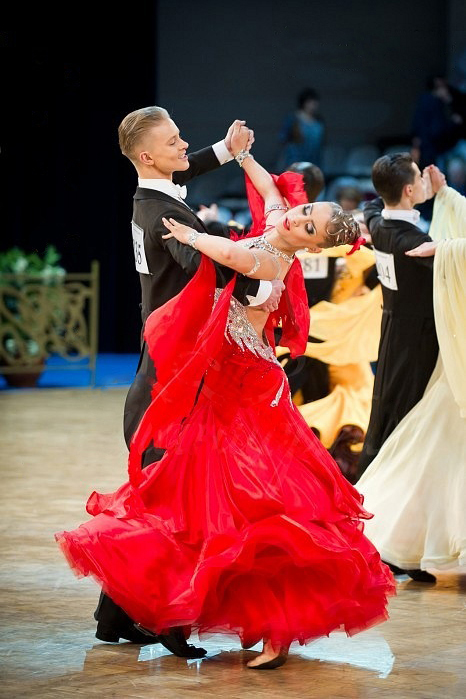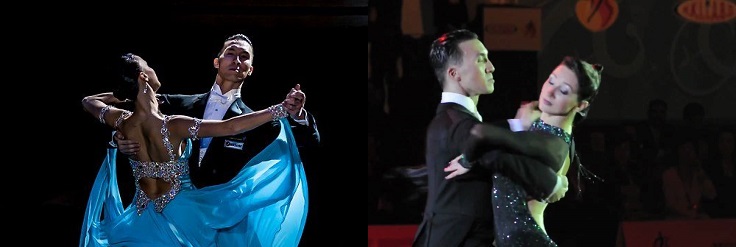Difference between revisions of "Frame"
From Londonhua WIKI
| Line 33: | Line 33: | ||
}} | }} | ||
<br> | <br> | ||
| − | The frame for [[Ballroom Dance Categorization|Smooth]] and [[Ballroom Dance Categorization|Standard]] dances | + | The frame for [[Ballroom Dance Categorization|Smooth]] and [[Ballroom Dance Categorization|Standard]] dances is characterized by lowered shoulders and raised elbows. Specifically, the [[Leader and Follower|leader's]] elbows are raised until his upper arms are parallel with the ground. The leader's shoulders will be parallel with the follower's. The leader will also have a straight line from his right shoulder to his left elbow. For the [[Leader and Follower|follower]], elbows may either parallel with the ground or slightly raised. There should also be a straight line from the follower's right shoulder to her left elbow<ref>Frame and Elbows. (2016, February 26). Retrieved May 11, 2017, from http://www.ballroomguide.com/resources/blog/2016_02_26_frame_and_elbows.html</ref>. |
<br><br> | <br><br> | ||
Revision as of 16:22, 17 May 2017
Frame
 | |
| Ballroom Frame | |
|---|---|
| Credit: | Caragiuss[1] |
Overview
Frame and posture are two of the most visually recognizable features of ballroom dances, and are often used to distinguish between amiture dancers and masters.
Contents
Background
 | |
| In 2016, Victor fung was considered to have the best frame in the world[2] |
|---|
Frame and posture differ from one dance to another, but are always characterized by the shoulders being down and back and by the sternum being raised. Frame is especially important in Standard and Smooth Dances. As of 2016, Victor Fung, a Professional Standard World Finalist, is considered to have the best frame in the world[3].
Smooth/Standard Frame
 |
The frame for Smooth and Standard dances is characterized by lowered shoulders and raised elbows. Specifically, the leader's elbows are raised until his upper arms are parallel with the ground. The leader's shoulders will be parallel with the follower's. The leader will also have a straight line from his right shoulder to his left elbow. For the follower, elbows may either parallel with the ground or slightly raised. There should also be a straight line from the follower's right shoulder to her left elbow[4].
Smooth/Standard Posture
For both Smooth and Standard dances, the spine is precisely arranged to accentuate normal good posture and project confidence and grace. To do this, the spine is extended and straightened. The belly button is pulled inward toward the spine, filling out the lower back. The collarbone is lifted, stretching the thoracic spine. The head then sits backward on the shoulders, with half of the head in front of the shoulders and the other half behind. For Standard dances, followers exaggerate their posture even further, bending backwards away from the leader[5].
References
- ↑ By Caragiuss (Own work) [CC BY-SA 3.0 (http://creativecommons.org/licenses/by-sa/3.0)], via Wikimedia Commons
- ↑ Frame and Elbows. (2016, February 26). Retrieved May 11, 2017, from http://www.ballroomguide.com/resources/blog/2016_02_26_frame_and_elbows.html
- ↑ Frame and Elbows. (2016, February 26). Retrieved May 11, 2017, from http://www.ballroomguide.com/resources/blog/2016_02_26_frame_and_elbows.html
- ↑ Frame and Elbows. (2016, February 26). Retrieved May 11, 2017, from http://www.ballroomguide.com/resources/blog/2016_02_26_frame_and_elbows.html
- ↑ Perfect Posture. (2016, May 25). Retrieved May 11, 2017, from http://www.ballroomguide.com/resources/blog/2016_03_25_perfect_posture.html